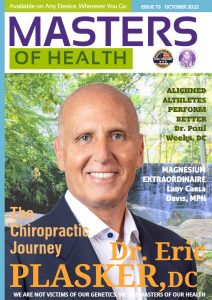The Chiropractic Journey to Essential

The Chiropractic Journey Begins
In 1895, during the Second Industrial Revolution, life expectancy was 46.3 years for women and 48.3 years for men. The concept of public health in the US had just come into being in the 1870s and 1880s. It was industrialization and rapid population growth in the big cities of the East coast that made public health a topic of concern.
During this time, many important steps were made in the field of public health. Among them: French chemist and microbiologist Louis Pasteur had introduced the germ theory of diseases; German physician and microbiologist, Robert Koch formulated his postulates on modern bacteriology; and Claude Bernard began and Antoine Bechamp expanded upon terrain theory, which states that a healthy internal environment can innately handle the various pathogenic microorganisms that come its way.
This same year, 1895, the history of chiropractic began when Daniel David Palmer performed an adjustment on a partially deaf janitor, Harvey Lillard. During an examination, Palmer noticed Lillard had a vertebra out of position. He performed spinal adjustments on Lillard that also restored Lillard’s hearing and word began to spread.
D.D. Palmer asked his patient and friend, Rev. Samuel Weed, to help him name his discovery. Rev. Weed suggested combining the Greek words cheiros and praktikos (meaning “done by hand”) to describe Palmer’s treatment method, creating the term “chiropractic.”
While Palmer gave chiropractic care its name, the discussion of the importance of spinal health to whole body health was nothing new. It was Hippocrates, the Greek physician who lived from 460 to 357 B.C., who is quoted from his writings as saying, “Get knowledge of the spine, for this is the requisite for many diseases.” Clearly, Palmer was in good company.
Grass Roots Movement
In 1896, fueled by his success with his patients, Palmer began to teach others his method. His efforts would become the Palmer School of Chiropractic (now Palmer College of Chiropractic). Among the first graduates was BJ Palmer, DD’s son, who had taken an interest in his father’s work and who later in 1902 assumed responsibility for the school following his graduation.
Together, between 1906 and 1949, they published the first of what would become a series of 46 books called the “Green Books.” Their first work was called, The Science of Chiropractic; Its Principles and Adjustments.
While many may not think of it in these terms, chiropractic’s growth has been a grass roots movement since the beginning. It was an organized effort undertaken by a group of individuals, initially in and around Iowa, who sought and fought for the right to give people a healthy alternative to available healthcare. Healthcare freedom has been in the chiropractic DNA since its inception, and still is today.
Meanwhile, around this time, on January 2, 1903, in a publication called The Newark Advocate, in a piece titled “The Edison Wizard,” Thomas Edison, concerned about the healthcare of his time, stated: “The doctor of the future will give no medicine, but will interest his patient in the care of the human frame, in diet, and in the cause and prevention of disease.” This light bulb of an idea burns as brightly today in the hearts and minds of chiropractors and other healers as it did then.
Courage, Sacrifice, & a Commitment to Principle
The early years of chiropractic brought many challenges. Its history is filled with courageous individuals (starting with D.D. Palmer), who faced personal hardship rather than abandon their values and commitment to their patients. To counter, medical politics grew tougher and in 1907, practicing medicine without a license led to many chiropractors, including D. D. Palmer, being jailed. When asked why he didn’t just pay the fine instead, D.D. responded, “I am not in a cell for lack of principal but for an abundance of principle.” Palmer was practicing chiropractic, not medicine.
Despite these attacks and other personal hardships, momentum built as more and more chiropractors were trained and their services made available to the public. Over a period of 15 years, thirty more chiropractic schools opened. Each school attempted to develop its own identity, while B.J. Palmer continued to develop the philosophy, science, techniques, and technology behind his father’s discovery.
Prosecuted
B.J. Palmer’s passion, innovation, and entrepreneurial genius grew and led the profession forward. Being also a researcher, writer, and entrepreneur, he took the message of chiropractic care to the masses through radio, seminars, advertising, and politics.
Incensed by the persistent and provocative advertising of chiropractic graduates, local medical communities, who had the power of the state at their disposal, immediately had them arrested. In the first thirty years of the chiropractic profession’s existence, there were more than 15,000 prosecutions, of which about 20 percent resulted in incarceration.
In 1907, Chiropractors won their first case, in Wisconsin. However, prosecutions instigated by state medical boards became common and were successful in many instances. In response, chiropractors conducted political campaigns from 1913 to 1974 where they succeeded in securing separate licensing statutes in all fifty states. Today, all fifty states, the District of Columbia, the Virgin Islands, and Puerto Rico grant licenses and regulate the practice of chiropractic.
Technical Masters, Healers, Emerge
Being under this scrutiny built a warrior mentality into many of the early chiropractors who were inspired by chiropractic’s patient successes, which very often came following medical failures. An abundance of technique masters with strong personalities and skills emerged with unique ways to locate and correct vertebral subluxations and help the body heal itself. This created technique debates, spurred a healthy attitude, and sometimes unhealthy feuds about “my technique is better than your technique.”
The reality is that the majority of their results were fantastic and became reproducible by the doctors they taught. This helped create a chiropractic culture of patient results that still exists today.
AMA Slander Leads to Major Chiropractic Lawsuit Victory
In 1963, despite or perhaps because of the growing successes in the chiropractic community, the American Medical Association (AMA) created a massive, focused slander campaign. This campaign was almost exclusively against chiropractors. Their efforts went on until 1976, when Illinois chiropractor Chester Wilk and four other Doctors of Chiropractic filed a lawsuit against the AMA.
It wasn’t until 11 years later, on August 27, 1987, when victory was won. The AMA was found guilty in United States District Court for having conspired to destroy the chiropractic profession. Evidence presented during the trial showed how the AMA and other defendants actively but covertly tried to:
- Undermine chiropractic educational institutions.
- Hide evidence of the uses and benefits of chiropractic care.
- Undercut insurance programs for patients of chiropractors.
- Subvert government inquiries into the efficacy of chiropractic care.
It was also found that they participated in a large-scale disinformation campaign to discredit the chiropractic profession.
Victory
During this time, because chiropractors were constantly fighting for survival, they were unable to generate substantial resources for research. However, in 1975, the National Institutes of Health brought chiropractors, osteopaths, medical doctors, and PhD scientists together in a conference to develop strategies to study the effects of spinal health.
In 1978, the Journal of Manipulative and Physiological Therapeutics (JMPT) was launched, and in 1981 it was included in the National Library of Medicine’s Index Medicus. The AMA boycotted it until losing the 1987 antitrust case.
This major court victory gave the chiropractic industry a much-needed boost. Chiropractic colleges and associations began forming their own research teams to explore the more vitalistic results that chiropractors were seeing in the field. These results were related to the correction of vertebral subluxations, the impact on the brain, lifestyle care, and more.
Chiropractic’s Terrain Theory Roots
The basis of the chiropractic perspective began with D. D. Palmer, who wanted to know “why two people sitting at the same table, eating the same food, breathing the same air, and one would get sick, and one wouldn’t.” In light of recent world-wide events, this question is equally relevant today. More and more people are questioning the germ theory and looking for help in supporting their body’s innate intelligence to make themselves stronger and less vulnerable. With an artificial intelligence takeover looming, this questioning is vital.
Chiropractic care offers this support. Perhaps the most noticeable distinction between chiropractic care and allopathic care is that chiropractic care focuses on the body’s innate intelligence, self-healing, self-regulating qualities, and human potential.
As more and more people shift their values in this direction, it has created a greater need for chiropractors. Today there are 19 chiropractic school in the US, and 20 more around the world. In the US alone, there are just shy of 70,000 chiropractors and 10,000 chiropractic students. Approximately 35 million American adults and children receive chiropractic care each year.
Community Leadership Today
Today, chiropractors are taking the lead, being the first choice for healthcare because of their safe, holistic approach. In communities where chiropractic is more established, it is common to see the “you go to a chiropractor” conversation replaced by, “who’s your chiropractor?”
It is indisputable that a healthy spine and nervous system are essential for a healthy, long life. Everyone benefits from regular chiropractic check-ups! Many chiropractors across the country are providing this health leadership for their communities.
Living a healthy lifestyle, eating right, and exercising are not enough if your spine and nervous system are not healthy. This can severely impact your quality of life. The degeneration can be devastating. Because the nervous system is affected, the consequences of lack of care are more than musculoskeletal. They can be systemic.
Chiropractic is not about just treating symptoms, it’s about optimizing the function of the nervous system.
As the profession grows in techniques, technology, and reach, chiropractors are often at the center of healthy collaborative relationships. These relationships are often with Naturopathic Doctors, Functional Health Doctors, Nutritionists, MDs, and other chiropractors. This has benefited the sick and suffering, high achieving athletes, and everyone in between.
Named Essential
Additionally, chiropractic education is transforming with several of the chiropractic colleges achieving University status. These institutions not only teach technique but leadership as well. They encourage communication, research, informed consent, the Hippocratic Oath, and conservative care first. Which is why it is one of the safest professions on record with professional liability carriers.
Today’s modern chiropractic care includes pediatrics, family care, generational care, sports chiropractic, brain health, nutrition, injury care, wellness care, animal chiropractic, and more. And while most insurance companies and Medicare cover a portion of chiropractic services, many people choose to pay for their ongoing care. They do this because they value the proven benefits they receive.
While to their patients’ chiropractors have always been essential, during the height of the pandemic, Chiropractors were named “Essential Healthcare Workers” by the U.S. Department of Homeland Security.
Healthcare is going through radical changes. We are facing daunting challenges with more on the way.
Fortunately, the chiropractic journey continues to grow, and the best is yet to come!
- SHARE THIS POST


